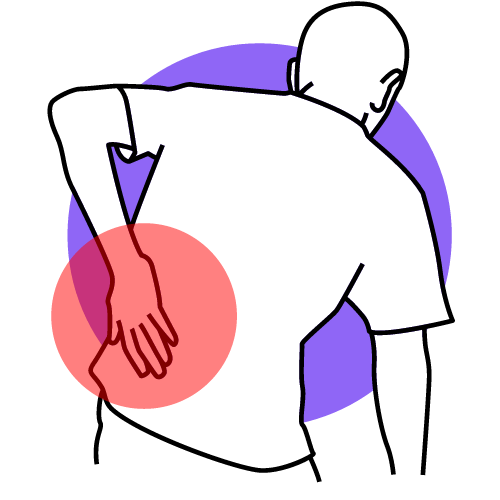Often, individuals in sedentary roles experience chronic and debilitating back pain due to poor ergonomics at their workstations.
This can lead to decreased productivity, increased sick days, and long-term health complications.
However, with the proper physical therapy techniques and a focus on ergonomics, many individuals can find relief from their work-related back pain.
In this blog post, we will explore the most effective physical therapy techniques and ergonomic adjustments that can alleviate back pain and improve overall well-being in the workplace.
Key Takeaways:
- Ergonomics is crucial for preventing work-related back pain: Proper ergonomic design can help workers maintain correct posture and reduce strain on the back, ultimately preventing work-related back pain.
- Physical therapy techniques play a significant role in alleviating work-related back pain: Various physical therapy techniques, such as therapeutic exercises, manual therapy, and modalities, can help reduce pain and improve function in individuals with work-related back pain.
- Education and training are essential for promoting proper body mechanics: By educating and training workers on proper body mechanics, they can learn how to move and work ergonomically and reduce the risk of developing back pain.
- Creating a supportive work environment is crucial in preventing work-related back pain: Employers should prioritize creating a supportive work environment that promotes proper ergonomics and provides physical therapy resources for employees with work-related back pain.
- Early intervention is critical to managing work-related back pain: Implementing physical therapy techniques and ergonomic interventions early on can help manage and alleviate work-related back pain before it progresses into a chronic condition.
The Science of Ergonomics

Now, let’s delve into the science of ergonomics and its impact on the workplace.
Ergonomics is the study of designing and arranging products and work environments to fit the people who use them.
Ergonomics aims to create a comfortable and efficient work environment that minimizes the risk of injury and maximizes productivity.
Ergonomic Risk Factors for Office Workers
Ergonomics identifies several risk factors that can contribute to work-related back pain for office workers.
These include poor posture, prolonged sitting, awkward positioning, and repetitive tasks.
Additionally, improperly adjusted furniture and equipment can also contribute to musculoskeletal discomfort.
Recognizing and addressing these risk factors is crucial in alleviating work-related back pain and improving overall well-being.
Implementing Ergonomic Solutions in the Work Environment
Implementing ergonomic solutions is essential for companies looking to reduce the risk of work-related back pain.
This involves providing ergonomically designed furniture and equipment, offering training on proper workplace ergonomics, and conducting regular work environment assessments to identify and address potential ergonomic issues.
By prioritizing ergonomics, companies can create a safer and more comfortable work environment for their workers, leading to increased productivity and reduced absenteeism.
Workers play a crucial role in maintaining proper ergonomic practices as well.
Workers need to engage in regular stretching and movement throughout the workday and communicate any discomfort or ergonomic issues to their supervisors.
By actively participating in ergonomic solutions, workers can help create a healthier and more productive work environment for themselves and their colleagues.
Physical Therapy for Back Pain

Your journey to alleviating work-related back pain through physical therapy begins with a comprehensive assessment by a qualified physical therapist.
Based on the findings of this assessment, a personalized treatment plan will be developed to address your specific needs and goals.
Assessment of Work-Related Back Injuries
An initial assessment is *critical* in determining the root cause of your work-related back pain.
This may involve a combination of clinical examination, diagnostic tests, and a detailed review of your work environment and ergonomic practices.
*Identifying* the underlying factors contributing to your back pain will guide the development of an effective treatment plan for back pain.
Core Physical Therapy Techniques
One of the *foundational* approaches to treating work-related back pain is through core strengthening and stabilization exercises.
These exercises are designed to improve the strength and endurance of the muscles in your back, abdomen, and hips, providing *support* for your spine and promoting proper posture and alignment.
Manual therapy techniques such as spinal manipulation and mobilization may also alleviate pain and improve *mobility* and function.
Therapy sessions will also include education on proper body mechanics, ergonomics, and *postural* awareness to help you prevent future injuries and manage your symptoms effectively.
By incorporating these techniques into your daily routine, you can experience long-term relief from work-related back pain.

Advanced Physical Therapy Interventions for Chronic Conditions
Advanced physical therapy interventions may be necessary for individuals with chronic or severe work-related back pain.
These interventions may include:
- Manual Therapy: Hands-on massage, joint mobilization, and soft tissue mobilization to improve tissue flexibility and reduce pain.
- Therapeutic Exercise: Customized exercise programs to improve strength, flexibility, and endurance, tailored to your needs and limitations.
- Pain Management Techniques: Modalities such as heat, ice, electrical stimulation, and ultrasound to alleviate pain and promote healing.
- Education and Counseling: Guidance on pain management strategies, lifestyle modifications, and coping strategies to improve overall well-being.
Physical therapists are *highly* trained professionals who can provide comprehensive care for individuals with chronic work-related back pain.
These interventions aim to address the underlying factors contributing to your pain and *empower* you to take control of your health and well-being.
Integrating Ergonomics and Therapy
Despite the advancements in technology and workspace design, many individuals continue to suffer from work-related back pain.
To address this issue, integrating ergonomics and therapy has become crucial in alleviating discomfort and promoting overall wellness in the workplace.
Developing a Personalized Ergonomic and Therapy Plan
Therapy professionals collaborate with ergonomics experts to develop personalized plans for individuals experiencing work-related back pain.
This includes assessing the individual’s work environment, posture, and daily activities to identify potential ergonomic risk factors.
Additionally, therapy techniques such as stretching exercises, postural correction, and ergonomic modifications are incorporated into the plan to address specific physical needs and limitations.

Case Studies and Success Stories
Success stories of individuals who have benefited from integrating ergonomics and therapy provide valuable insight into the effectiveness of this approach.
Several case studies have shown a significant reduction in back pain and discomfort, with some individuals experiencing complete resolution of their symptoms.
- Case Study 1: A 35-year-old office worker experienced a 40% reduction in back pain after implementing an ergonomic desk setup and participating in therapy sessions.
- Case Study 2: A 40-year-old nurse reported complete resolution of lower back pain after incorporating ergonomic techniques and participating in a tailored therapy program.
It is evident from these case studies that the integration of ergonomics and therapy has the potential to significantly improve the well-being of individuals suffering from work-related back pain.
By addressing the root causes of discomfort and implementing personalized interventions, individuals can experience a drastic reduction in pain and significantly improve their overall quality of life.
Maintenance and Prevention

Unlike short-term solutions that provide temporary relief, it is crucial to implement long-term strategies to sustain a healthy back and prevent work-related back pain.
Consistent maintenance and prevention techniques are vital in reducing the risk of future issues and promoting overall well-being in the workplace.
Long-Term Strategies to Sustain a Healthy Back
For individuals looking to maintain a healthy back, it is essential to prioritize regular exercise, maintain a proper posture, and incorporate ergonomic products into their daily routine.
Strengthening the core muscles, stretching regularly, and focusing on overall body alignment can all contribute to a healthy back, reducing the likelihood of work-related pain and discomfort over time.
Proactive Exercises and Habits to Avoid Back Pain
Maintenance and prevention go hand in hand when avoiding back pain in the workplace.
Implementing proactive exercises and habits, such as taking regular breaks to stretch, adjusting your workstation, and practicing good body mechanics, can significantly reduce the risk of developing work-related back pain.
Integrating these habits into your daily routine is essential to promote a healthier and pain-free work environment.
It is crucial to prioritize maintaining and preventing work-related back pain to sustain a healthy back over time.
By incorporating long-term strategies, proactive exercises, and healthy habits into your routine, you can reduce the risk of developing pain and discomfort in the workplace, ultimately promoting overall well-being and productivity.
Conclusion
From the above, it is evident that incorporating ergonomic principles and physical therapy techniques in the workplace can significantly alleviate work-related back pain.
By addressing poor workstation setups and providing targeted exercises and stretches, employees can experience relief from discomfort and prevent further injury.
Employers can significantly benefit from investing in ergonomic assessments and therapy services to improve employee productivity and reduce the costs associated with work-related back pain.
Both employees and employers must recognize the importance of incorporating ergonomics and therapy into the workplace to create a safe and healthy environment.

FAQ On Work-Related Back Pain
What is ergonomics and its relationship to work-related back pain?
Ergonomics studies people’s efficiency in their working environment. Work-related back pain can be alleviated through proper ergonomics, which involves arranging the workspace to fit the individual’s body and tasks.
How can physical therapy techniques help alleviate work-related back pain?
Physical therapy techniques can address the root cause of work-related back pain by strengthening muscles, improving flexibility, and correcting posture and body mechanics.
What common ergonomic risk factors contribute to work-related back pain?
Common ergonomic risk factors include poor posture, repetitive movements, lifting heavy objects, prolonged sitting, and awkward work positions.
What are some recommended ergonomic adjustments to prevent work-related back pain?
Recommended ergonomic adjustments include using an adjustable chair with proper lumbar support, maintaining neutral body positioning, taking regular breaks to move and stretch, and using ergonomic tools such as keyboards and mouse pads.
What are some physical therapy techniques commonly used to alleviate work-related back pain?
Common physical therapy techniques include manual therapy, therapeutic exercises, ergonomic education, and modalities such as heat or ice therapy.
How can an individual maintain good ergonomics in their daily work routine?
Individuals can maintain good ergonomics by practicing proper posture, taking regular breaks to stretch and move, adjusting their workstations to fit their bodies and tasks, and seeking ergonomic assessments from qualified professionals.
What are the long-term benefits of integrating ergonomics and physical therapy for work-related back pain?
Integrating ergonomics and physical therapy can lead to long-term benefits such as reduced risk of injury, improved overall health and well-being, increased productivity, and enhanced quality of life.






